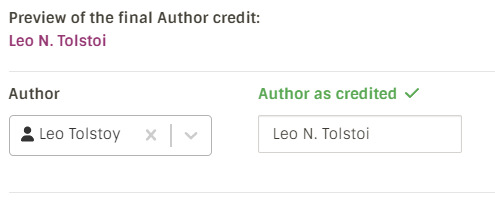Work
A work is a distinct, notable literary creation. The work entity captures information about the content that was created, not any physical or digital representation.
Distinctiveness
A work is considered distinct based on the substantive uniqueness of its content. A work is distinct from another if it is revised, adapted, translated or reconstructed. Content is not considered a distinct work if it only contains minor variations such as spelling or typographical differences.
Sometimes content is integral to a work and is not considered distinct from it. In general, chapters of a novel are not considered to be their own distinct works. Poems, essays, articles and short stories are generally considered distinct works.
Naming
The name of a work should be its canonical title, in the language it was written by its author, or translator of translated works. Additional names, such as descriptive titles, known variations or transliterations should be included as aliases.
The language of a work’s name can differ from the language of the actual work. For example, a work written in English can have a Latin name. The name of the work should be capitalized based on the rules of the language of its name.
Untitled works
If a work does not have a title, the name of the work should be the first line or sentence of the work’s text, enclosed in square brackets. Do not apply capitalization rules; retain the case of the original text. Examples:
The sort name of an untitled work should be the same name, omitting the square brackets.
Writer
The primary relationship of a work is to its main author, aka its writer; every work should have at least one writer.
A work’s writer can be a special-purpose author in specific cases:
- Anonymous writer. If a work cannot be attributed to a specific writer (e.g. published anonymously or writer attribution has been irrecoverably lost) it should be related to [anonymous].
- Unknown writer. If the author of a work is currently unknown, but can potentially be determined at a later date, it should be related to [unknown].
- Oral tradition. If a work has been preserved in the oral tradition (e.g. received, preserved, and transmitted orally from one generation to another) it should be related to [traditional].
Translations
Each translation of a work is distinct from the original work as well as from any other translations. A translated work should be related to the original work as a translation.
A translated work should have a writer relationship to the original work’s author, and a translator relationship to its translator. Example:
- Republic was written by Πλάτων
- Republic is a translation of Πολιτεία
- Republic was translated by Benjamin Jowett
If the translator is unknown or unidentified, the translator should be [unknown].
Notable information about a translation should be documented in the work’s annotation.
Work relationships
A work should be related to another work if:
- it is derived from another work, for example: a translation, an adaptation, a revision, a reconstruction, a parody, an inspiration;
- it contains the content from another work or is contained in another work, for example: a fix-up, a poetry cycle, an excerpt, a quote;
- it references another work, for example: a citation.
Except for cases such as a fix-up or a poetry cycle as mentioned above, a discrete work should not represent a collection of works.
